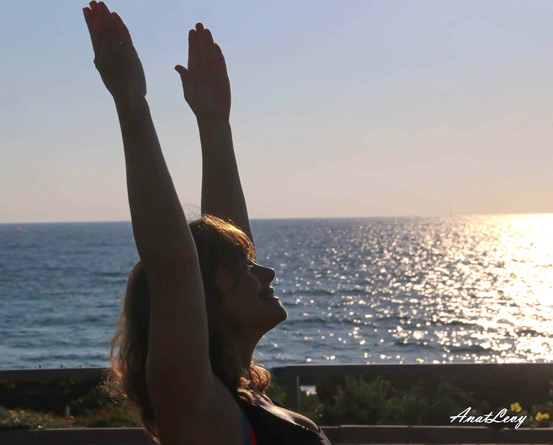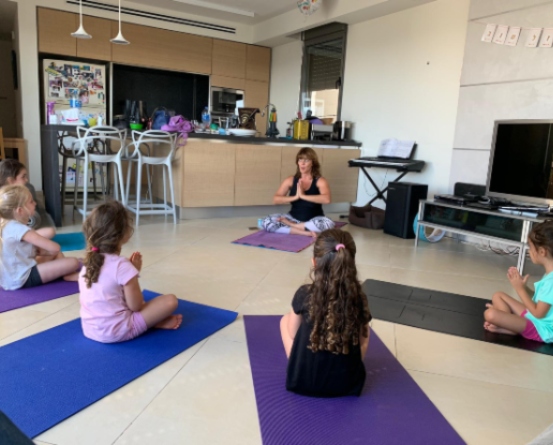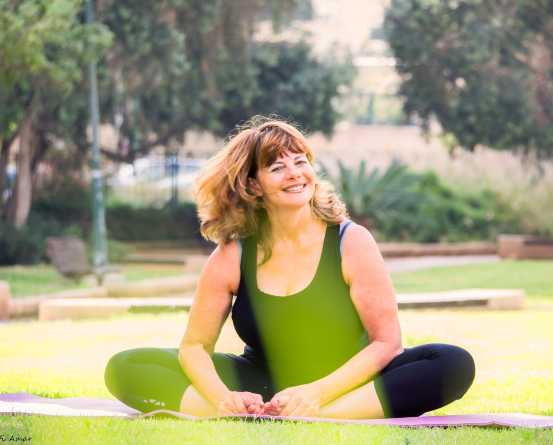Yoga in Life

Is Yoga Right for Me?
7 בDecember 2018
Yoga Breathing and Pranayama
9 בDecember 2018
Yoga in Life
The ultimate goal of yoga is to provide us with tools that will improve the quality of our life.
We attain and practice tools that enable us to handle stressful situations, hardships, challenges and changes in our lives and learn to become more calm, more focused, empowered and at peace with ourselves in order to be able to reach and fulfill our goals and dreams.
The Breath
The main tool we use in our yoga practice is the breath. We develop breath awareness, learn to breathe deep, long breaths and allow the breath to lead our practice (See article “Yoga Breathing”).
By practicing deep balanced breathing in our yoga practice on the mat, we learn to breathe and calm ourselves during stressful situations in our daily lives.
We are able to change behavioral patterns and cope with challenging situations more calmly, quietly and efficiently.
We develop a sense of inner peace and calmness that improve the quality of our life.
Mindfulness
One of the most basic principles in yoga is: “Yoga Now” (“Atha yoganushasanam”) which teaches us that we must practice yoga every moment and be fully present and aware in the moment: mindfulness.
When we are in a state of “yoga”, we experience inner peace, tranquility and serenity.
The problem is that our mind constantly experiences “noises” (vrittis) that disturb our peace and balance. (See article “Yoga Philosophy”).
When we allow ourselves to be controlled by our thoughts, we are bound by these noises and live in suffering and fear.
Most of our suffering arises from our thoughts about the past or fear of the what may happen in the future, which has no connection to present reality.
Our fears arise from our mind and are, therefore, imaginary with no bearing on reality.
When we practice yoga, we practice being present in the moment (mindfulness), releasing thoughts and fears from the past and of what may happen in the future.
Regular yoga practice aids in reducing stress and fears and enables us to live calmer, peaceful, healthier, happier lives.
Focus
Yoga teaches us the principle of “Drishti” which means “focal point”.
In every pose we practice on the mat, we must find our focal point: a static point to gaze at, in order to remain stable, balanced and practice the pose more precisely.
When we practice focus and intention on the mat, we can apply this principle in our lives: Set goals, intentions, focus, balance ourselves and attain our goals and dreams and create the reality that we want.
Grounding and Reaching
In every yoga pose that we practice on the mat, we ground ourselves while reaching upward and must find the balance between the two.
For example: In standing poses, our lower body pulls us to the earth (grounds us and stabilizes us), our upper body lifts us up (helps us reach for our goals and dreams) and we must find the balance between the two: grounding and reaching.
We learn to apply this principle in life:
In order for us to be able to achieve our goals and dreams, we must ground ourselves, find our balance and stability and only then lift up and manifest our goals and dreams.
Finding The Ease within the Effort (“Sthira Sukha”)
Yoga philosophy teaches us the principle of “Sthira Sukha” which means “finding the ease within the effort” or “remaining flexible while engaging”.
In every pose that we practice, we must find the balance between the effort and the ease and the poses must feel comfortable, steady and stable.
We practice the principle of “Sthira Sukha” on the mat so that we may apply it to our daily lives: In order to fulfill and achieve our goals and dreams, we must find the ease within the effort, remain calm and learn to release and let go while in the midst of working hard.
Flexibility and Non-Attachment
Many times during our lives we find ourselves becoming rigid and holding on to situations, objects, people and ideas that no longer serve us and find that the more we try to hold on, the more they get away from us.
Our fear builds up and we live in constant suffering and pain.
Yoga teaches us flexibility and “non-attachment” which states that we must not hold on to objects, people or ideas since attachment leads to suffering, fear, and constant anxiety that the object of our attachment will evade and pass and we won’t be able to function without it.
We can practice flexibility and “non-attachment” during our practice on the mat by observing our behavior while attempting to practice challenging poses that may not be suitable for us.
We must learn to let go of poses that are no longer suitable for us, find new variations for them (with the guidance of a certified yoga teacher) or even let go of them completely.
Since we are constantly changing and evolving, perhaps a pose that was once right for us, is no longer suitable.
Change is an integral part of life. We are constantly changing, our thoughts are just thoughts, our possessions, our body and our relationships don’t define us.
We must remember that, even if our everything around us changes, our soul remains strong and stable and we can relax, let go, surrender to the universe and enable wonderful new opportunities and experiences to come our way!
"Flexibility is defined as being adaptable to change. In the course of your lifetime, you will be tempted to try to hold on to what is, when in fact, what is only a temporary phase that evolves almost immediately into what was. It is essential that we learn to bend and flex around every new circumstance, as rigidity robs us of the opportunity to see the freedom of new possibilities. In order to truly embrace our role as a student of life, we must cultivate the ability to move easily from "knowingness" to "not-knowingness", which in turn moves us from master to student again and again."~ Cherie Carter-Scott
“True yoga is not about the shape of your body, but the shape of your life. Yoga is not to be performed; yoga is to be lived. Yoga does not care about what you have been; yoga cares about the person you are becoming.” ~ Aadil Palkhivala






